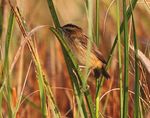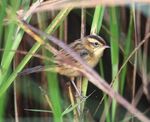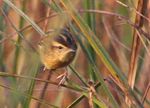Photospot: First photographs of Aquatic Warbler Acrocephalus paludicola in the field from Africa and a request for observations
←
→
Page content transcription
If your browser does not render page correctly, please read the page content below
Photospot:
First photographs of Aquatic Warbler Acrocephalus paludicola in the
field from Africa and a request for observations
Volker Salewski
Premières photos du Phragmite aquatique Acrocephalus paludicola sur le terrain en Afrique. Le
Phragmite aquatique Acrocephalus paludicola est le seul passériforme mondialement menacé nichant en
Europe continentale. La localisation des sites de stationnement et quartiers d’hivernage en Afrique s’avère
essentielle à la conservation de l’espèce mais est gênée par le manque de connaissances de cette espèce rare
de la part des observateurs. L’auteur présente probablement les premières photos de l’espèce dans son
habitat naturel en Afrique de l’Ouest et décrit les critères d’identification principaux, surtout par rapport au
Phragmite des joncs A. schoenobaenus. Finalement, un appel est lancé aux observateurs pour envoyer toutes
leurs données à l’Équipe de Conservation du Phragmite aquatique de BirdLife International.
A quatic Warbler Acrocephalus paludicola is the
only globally threatened passerine species
that breeds in continental Europe. Formerly more
wintering site was found in Mali (Poluda et al.
in press). In order to implement a conservation
strategy for Aquatic Warblers during the non-
widespread, its population decreased dramatically breeding season, the species’ precise wintering
during the 20th century (Flade & Lachmann areas in Africa must be identified. However,
2008). The species is a migrant, spending the non- finding the species requires knowledge of its
breeding season in sub-Saharan Africa, but until preferred habitats and identification may present a
recently no wintering areas were known. In 2007 challenge to observers unfamiliar with the species.
an important non-breeding site was discovered To my knowledge, there are no photographs
around Djoudj National Park in northern Senegal of Aquatic Warblers in their natural habitat
(Salewski et al. 2009) and in 2011 a second on the wintering grounds. In January 2010,
several Aquatic Warblers were photographed in
the Djoudj area. These photographs are presented
here along with a discussion of identification
criteria to aid searches for Aquatic Warblers in
suitable habitat throughout West Africa.
A. paludicola is a small brownish-buff warbler
with heavily streaked upperparts and a striped head,
and is similar to the very common Sedge Warbler
A. schoenobaenus, with which it co-occurs. The
head pattern of Aquatic Warbler is characterised
by a distinct buffish-white supercilium and a
well-marked whitish central crown-stripe (Fig. 1).
In general, Sedge Warblers lack such a distinct
Figure 1. Aquatic Warbler Acrocephalus paludicola; the pale stripe on the crown, but in first-winter
distinct well-defined stripe on the crown is characteristic birds it can be quite obvious. Sedge Warblers
(beware of first-year Sedge Warblers A. schoenobaenus often possess more pronounced black lores (Fig.
showing this feature!), as is the very narrow ill-defined 2) than Aquatic Warblers (Fig. 1). In addition,
pale lores, Djoudj area, Senegal, January 2010 (Volker Aquatic Warblers are brighter overall and more
Salewski) yellow-toned (Fig. 3), whereas Sedge Warblers
Phragmite aquatique Acrocephalus paludicola ; la nette are more brownish (Fig. 2). Although Sedge
bande médiane étroite et jaunâtre sur la calotte est Warblers possess some dark mantle streaking
caractéristique (attention aux Phragmites des joncs A.
schoenobaenus de 1ère année présentant ce trait !), ainsi
(Fig. 2), this character is never as developed as
que les lores pâles très étroits et mal définis, zone du in Aquatic Warbler, which also has two distinct
Djoudj, Sénégal, janvier 2010 (Volker Salewski) whitish-buff lines on the sides (Fig. 4). In Aquatic
Photospot: Aquatic Warbler Bull ABC Vol 19 No 2 (2012) – 217Figure 2. Freshly-moulted Sedge Warbler Acrocephalus schoenobaenus; this bird is distinguished from Aquatic Warbler
A. paludicola by the dark lores, the brownish and only faintly streaked mantle, the unmarked tawny-brown rump,
the lack of fine streaking on the flanks and the greyish legs, Djoudj National Park, Senegal, February 2007 (Volker
Salewski)
Phragmite des joncs Acrocephalus schoenobaenus fraîchement mué ; cet oiseau se distingue du Phragmite aquatique A.
paludicola par les lores sombres, le manteau brunâtre et peu rayé, le croupion brun-jaunâtre uniforme, l’absence de fines
rayures sur les flancs, et les pattes grisâtres, Parc National du Djoudj, Sénégal, février 2010 (Volker Salewski)
Warblers, the mantle streaking continues onto
the rump (Fig. 4), whereas in Sedge Warbler the
rump has a uniform warm tawny-brown tone
(Fig. 2). Aquatic Warbler is finely streaked over
the breast and flanks (Figs. 3, 5), unlike adult
Sedge Warblers (Fig. 2). Although juvenile Sedge
Warbler can also show some streaking on the
breast and flanks, this is never as contrasting as
on Aquatic Warbler. Finally, the legs of Aquatic
Warbler are pinkish (Figs. 3, 5), whereas those of
Sedge Warbler are greyish (Fig. 2).
Several Afrotropical bird species may show
some of the same features as Aquatic Warbler,
including the streaked appearance or distinct
white supercilium and, in some species, even the Figure 3. Aquatic Warbler Acrocephalus paludicola;
whitish coronal stripe. Examples include females note the warm colour, the fine streaking on the flanks,
and the pinkish legs, whilst the pointed rectrices are
or eclipse males of some weavers, queleas and also characteristic of this species, Djoudj area, Senegal,
whydahs. However, all of these are large-billed January 2010 (Volker Salewski)
and they lack the warbler’s skulking behaviour. Phragmite aquatique Acrocephalus paludicola ; noter la
Some cisticolas potentially occur syntopically couleur chaude, les flancs finement striés et les pattes
with Aquatic Warbler, but all of them lack rosâtres, tandis que les rectrices pointues sont également
the latter species’ distinct head pattern. When caractéristiques de cette espèce, zone du Djoudj, Sénégal,
searching for Aquatic Warbler familiarity with its janvier 2010 (Volker Salewski)
218 – Bull ABC Vol 19 No 2 (2012) Photospot: Aquatic WarblerFigure 4. Aquatic Warbler Acrocephalus paludicola; Figure 5. Aquatic Warbler Acrocephalus paludicola;
although this bird is partially obscured by vegetation and although the central coronal stripe is not clearly visible,
the head is barely visible, the contrasting dark streaking the contrasting dark streaks on the mantle, the fine
on the mantle, the whitish-buff stripes on the ‘shoulders’, streaks on the flanks and the pinkish legs identify this
together with the streaks on the rump, characterise the individual, Djoudj area, Senegal, January 2010 (Volker
species, Djoudj area, Senegal, January 2010 (Volker Salewski)
Salewski) Phragmite aquatique Acrocephalus paludicola ; bien que
Phragmite aquatique Acrocephalus paludicola ; bien la bande médiane sur la calotte ne soit pas clairement
que l’oiseau soit partiellement caché par la végétation visible, le dessus aux rayures sombres bien marquées, les
et que la tête soit à peine visible, les rayures sombres flancs finement striés et les pattes rosâtres permettent
bien marquées dessus, les nettes « bretelles » chamois d’identifier cet individu, zone du Djoudj, Sénégal, janvier
encadrant le manteau, en combinaison avec le croupion 2010 (Volker Salewski)
strié, caractérisent l’espèce, zone du Djoudj, Sénégal,
janvier 2010 (Volker Salewski)
song (Chappuis 2000) will be useful as, at least
in January–February, Aquatic Warblers in the
Djoudj area regularly sing in the early morning
(Fig. 6).
Based on observations in the Djoudj area,
Aquatic Warblers exclusively occupy vast,
waterlogged open grassy marshes with very few or
no bushes or trees. Favoured areas are characterised
by relatively high coverage of Scirpus littoralis and
Sporobolus robustus, and moderate salinity (Fig. 7).
In addition to the Djoudj area, further wintering
areas are expected to occur in the Senegal Valley,
in the temporary lakes and flooded marshes of
southern Mauritania, as well as in the Inner Figure 6. Aquatic Warbler Acrocephalus paludicola
Niger Delta in Mali (Buchanan et al. 2011). singing, Djoudj area, Senegal, January 2010 (Volker
Nevertheless, Aquatic Warblers can be expected Salewski)
at any site on migration. In Africa, the species Phragmite aquatique Acrocephalus paludicola chantant,
has already been recorded in Tamarix bushes in zone du Djoudj, Sénégal, janvier 2010 (Volker Salewski)
coastal dunes, in papyrus stands within a hotel
garden, in date palm and rice plantations, and
within a mosque enclosure surrounded by dunes the south of any other known record (Hedenström
in the Sahara (Schäffer et al. 2006). Furthermore, et al. 1990), illustrates the capacity this species has
an Aquatic Warbler mist-netted in Ghana, far to to surprise.
Photospot: Aquatic Warbler Bull ABC Vol 19 No 2 (2012) – 219Acknowledgements
I thank Colonel Ibrahima Diop and the staff of
the Biological Station for hosting me in Djoudj
National Park. N. Seifert and S. Koschkar shared their
knowledge of Aquatic Warblers sites. I also thank M.
Flade for his help with the manuscript and D. Franklin
for kindly correcting the English.
References
Buchanan, G. M., Lachmann, L., Tegetmeyer,
C., Oppel, S., Nelson, A. & Flade, M. 2011.
Identifying the potential wintering sites of the
globally threatened Aquatic Warbler Acrocephalus
paludicola using remote sensing. Ostrich 82: 81–85.
Chappuis, C. 2000. African Bird Sounds: Birds of
North, West and Central Africa and Neighbouring
Atlantic Islands. 15 CDs. Paris: Société d’Études
Figure 7. Habitat of Aquatic Warbler Acrocephalus Ornithologiques de France & London, UK: British
paludicola during the non-breeding season, Djoudj area, Library National Sound Archive.
Senegal, January 2010 (Volker Salewski) Flade, M. & Lachmann, L. 2008. International Species
Habitat du site d’hivernage du Phragmite aquatique Action Plan for the Aquatic Warbler Acrocephalus
Acrocephalus paludicola, zone du Djoudj, Sénégal, janvier paludicola. Cambridge, UK: BirdLife International.
2010 (Volker Salewski) Hedenström, A., Bensch, S., Hasselqvist, D. &
Ottosson, U. 1990. Observations of Palaearctic
migrants rare to Ghana. Bull. Br. Ornithol. Cl. 110:
To date we possess only a rudimentary 194–197.
knowledge of the non-breeding ecology, phenology Poluda, A., Flade, M., Foucher, J., Kiljan, G.,
and distribution of Aquatic Warblers in Africa. It Tegetmeyer, C. & Salewski, V. in press. First
is therefore requested that observers report any confirmed connectivity between breeding sites and
records of the species to the BirdLife International wintering areas of the globally threatened Aquatic
Aquatic Warbler Conservation Team (www. Warbler Acrocephalus paludicola. Ring. & Migr.
aquaticwarbler.net/). Anyone can help collect Salewski, V., Bargain, B., Diop, I. & Flade, M.
useful information. Observers are requested to 2009. Quest for a phantom—the search for the
provide the following details: date and location winter quarters of the Aquatic Warbler Acrocephalus
(GPS data if possible), together with a short paludicola. Bull. ABC 16: 61–66.
habitat description (e.g. reeds adjacent to a river, Schäffer, N., Walther, B. A., Gutteridge, K. & Rahbek,
C. 2006. The African migration and wintering
Scirpus marsh in a floodplain, rice field, including
grounds of the Aquatic Warbler Acrocephalus
whether there was open water and its depth), a
paludicola. Bird Conserv. Intern. 16: 33–56.
description of behaviour (e.g. foraging, singing),
and the main features used to identify the bird. Dept. of Behavioural Biology, University Osnabrück,
Photographs will be extremely helpful even if the Barbarastr. 11, 49076 Osnabrück, Germany. E-mail:
bird was distant, as are sound-recordings which volker.salewski@biologie.uni-osnabrueck.de
can be made with most mobile phones in the Received 21 June 2011; revision accepted 2 December
absence of more professional equipment. 2011.
220 – Bull ABC Vol 19 No 2 (2012) Photospot: Aquatic WarblerYou can also read
























































